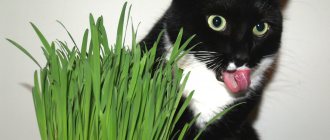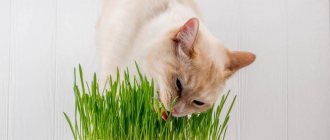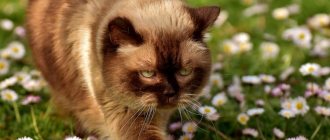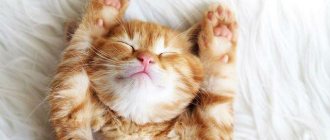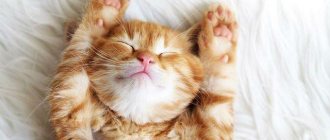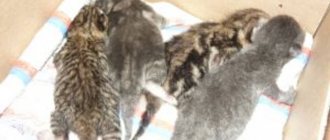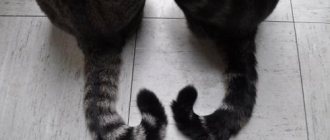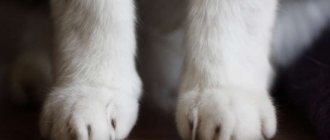Cats are carnivores; their diet is based on meat.
However, sometimes they prefer grass they find while walking or indoor plants. Experts consider this behavior to be natural. Greens help cats normalize digestion. Owners should definitely make a “bed” at home. This will prevent damage to decorative indoor flowers and prevent the possibility of poisoning by a harmful plant.
Reasons for temporary vegetarianism
All cats need grass: wild, outdoor, domestic. Becoming a vegetarian for a while is instinctive and natural.
It is not known exactly why cats eat grass, but there are several versions:
- the herb is a natural means of cleansing and stimulating the intestines, fighting parasites;
- the grass curls up into lumps along with the hair and is excreted by regurgitation or through the intestines;
- greens contain minerals, B vitamins, folic acid, which are not found in meat; cats know instinctively which greens are needed at a particular moment;
- some herbs contain substances that act as pain relievers on animals;
- sometimes cats just like the taste of greens.
You should not prohibit your domestic cat from eating grass while walking. It is necessary because it helps improve health and prolong life. There is an opinion that greens help against obesity if the cat is sterilized (neutered).
The situation is different with indoor flowers. Cats are not always able to determine which ones are likely to cause harm. Therefore, before planting new flowers on the windowsills, it is advisable to find out whether the cat can be poisoned by their leaves. If there are such indoor plants (dracaena, ficus, ivy, begonia), it is important to exclude the possibility of access.
Why do cats eat grass?
If a cat ate only grass or other food rich in protein, it would go blind, since the animal needs to eat meat and dairy products rich in vitamins, but why do animals eat grass while walking?
Scientists have not yet figured out why cats eat grass in their diet, but they have identified several versions:
- Animals eat plants to expand their diet. The composition includes many vitamins and microelements that improve the condition of pets. In cats, the circulation of oxygen in the blood improves; it is especially useful for pregnant cats to consume, as it promotes the bearing of kittens. However, it turned out that the elements contained in plants are synthesized independently, so it is believed that this is just a habit of pets.
- Previously, it was believed that cats eat herbs to heal, but after many studies it turned out that many medicinal herbs are contraindicated for cats and are harmful to animals.
- Some scientists believe that they like its taste. It could be repeatedly noticed that the cat only bites the plant and does not swallow it.
We grew a bush at home
Stomach cleansing
Greens cleanse your cat's stomach. A lump of vegetation moves through the animal’s stomach, thereby cleansing its walls. Thanks to this, the pet will be able to regurgitate unwanted products in its body.
In the wild, animals do not eat greens, since they enter their bodies with the animals they consumed as food.
Vitamins
The grass contains a number of amino acids, potassium, calcium, silicon, magnesium, sulfur, phosphorus, trace elements, vitamins B1, B2, B6 (β-carotene, E, choline, biotin, folacin).
Despite the fact that it contains many vitamins and minerals that help the cat’s body function, owners need to remember that sometimes the consumption of plants is prohibited for pets:
- If you live in a city, they can be filled with dust, toxins and other harmful substances.
- Some may have insect eggs, as well as worms.
- Not all cats have the ability to pick up quality grass.
Delicious treat
What greens do cats prefer?
Most often, representatives of the feline species eat creeping wheatgrass on the street. This is a weed that is not hard to find. Cats gnaw only on the juicy ends of the leaves, which contain carotene, fructose, and silicic acid. Dubnitsa and Dubrovka are also useful.
If animals are not taken out for walks, the owners must take care of the grass. Pet stores offer Avena sativa (common oats), but some pets don't like it. At home, wheat, barley, and sedge are most often planted. Almost all cats do not refuse grain sprouts.
You can buy grain at a pet store (oats can also be bought at a pharmacy) and sow it in a container for indoor flowers. Sprouts appear in a few days, and the cat can eat them in a couple of weeks. It is important to remember that cats can be harmed by oat inflorescences.
Some cat owners grow mint or lemon balm, but not every cat will eat them. In addition, these plants have different effects. Some animals calm down, others become activated, which is not always desirable. It is better to limit the consumption of lemon balm and mint. Essential oils in their composition can cause stomach upset.
For domestic cats, you can sow on the windowsill:
- catnip (catnip), containing phytohormones that energize;
- valerian;
- lemongrass
Although cats love valerian, it is difficult to grow it at home due to its large root system. Requires a pot with a volume of 5 liters, it must be placed in a place well lit by the sun.
Schisandra acts as a sedative on cats, cleanses the body, and relieves pain. It is not difficult to grow at home in a wide pot that is difficult to turn over. If vitamins are needed, parsley is planted, rosemary protects against fleas. Any plant must be fresh (held firmly in the ground by its roots), otherwise the animal will not eat it.
You shouldn’t grow all the herbs that cats love at home. Catnip and valerian act like a drug, which negatively affects behavior.
What kind of grass do they eat?
Often, breeders may notice that the pet is eating their indoor flowers or bouquets given to the owner, which is when they should think about growing grass for the pet.
If we talk about the taste of animals, they have a varied taste; of course, they are attracted to mint or valerian, but most often pets simply enjoy the smell of the plant and give their preferences to cereals.
Cats prefer grass that has just sprouted from the ground; it can be leeks or other plants: oats, barley, wheat, etc.
What indoor flowers can spoil?
Cat people often complain that their pets spoil their indoor flowers. The interest is not always gastronomic. They play with stems, dig in the soil, and turn over pots. Indoor flowers serve as a substitute for grass in winter. They are not always useful, often even poisonous. Cats will not touch flowers if greens are grown for them at home. This is especially important in the city, where the necessary plants cannot be found in the yard.
Ways to preserve indoor flowers:
- place in a place inaccessible to the pet;
- regularly spray with a solution of lemon juice, table vinegar or special sprays;
- place sprouted cereal next to it;
- cover the soil in pots with shells, pebbles, gravel;
- saturate the mulch with an unpleasant odor, cover with a plastic mesh;
- buy special grilles.
These measures will not help completely prevent damage to ornamental plants, but the risk will be reduced.
Following some simple rules also helps:
- plant flowers in hanging pots, on the walls;
- choose heavy containers;
- do not place plants on the windowsill too closely, use stands;
- secure racks and racks.
Ornamental plants can be protected with fences and display cases can be used.
Why does a cat eat flowers?
- Any cat can gnaw flowers, this does not depend on whether it lives at home or goes for walks. There are several factors due to which she eats house flowers:
- The animal wants to play with the flower. Initially, she may touch it with her paw and begin to bite.
- The desire to attract attention. Pets often play dirty tricks so that the owner will spend time with them.
- Digestive problems.
- By eating flowers, the animal can get rid of parasites, since excessive consumption causes vomiting in the pet.
How to make a “bed” in an apartment
Most often, grass seeds are purchased at pet stores and planted in a ready-made substrate, self-prepared soil mixture, or vermiculite.
Sequencing:
- soak the seeds for about three hours;
- pour soil into a pot or container for decorative indoor plants (2/3 of the volume);
- lay out the seed, cover with soil (2-3 cm);
- pour, cover with film.
The film is removed after seed germination. The sprouts are suitable for food after 2 weeks. To avoid a break, sowing is carried out every 3 weeks.
Some cat owners prefer to grow grass in plastic dishes. The bottom of a container with a smaller diameter is pierced in several places, cotton wool is laid out, moistened with water, seeds are poured in, and covered with gauze with large cells. A small plate is placed in a large one and covered with film.
Supplementing a cat's diet with grass is not necessary, but it is correct. It is useful if you use the one intended for pets. This is an additional source of minerals and vitamins that helps stabilize the functioning of the stomach and intestines. The home version is even better than the street version, since there is no risk of eating grass with parasites.
Beneficial properties of different types of herbs
Not all greens are created equal. It is better to plant several species at once, and then the pet will be able to make a choice.
Here is the grass that cats prefer:
- Wheat. Young sprouts have a pleasant sweetish taste. Wheat greens are rich in fiber and omega-3s. It is unpretentious, grows quickly and requires minimal care.
- Oats. Another plant rich in fiber. Green oats contain fats, amino acids and antioxidants.
- Barley. These greens stimulate metabolism. It contains beta-glucan and folic acid.
- Thyme. This herb has a calming effect.
- Wheatgrass. These greens most effectively cleanse your pet's stomach of fur.
- Licorice. It has a healing effect, accelerates the healing of the gastric mucosa, stimulates the digestion and endocrine system.
Seeds for germination can be mixed, then cats will be able to independently choose what to chew on.
Which seeds to choose
As has already become known, not every grass is suitable for planting. It is best to choose the seeds of oats, wheat, barley and other cereal plants at the pet store. And if you are not sure that this particular herb will help your pet, choose complex preparations, because the market does not stand still and is constantly evolving.
Different cats eat different grass
And yet, what is the best grass to plant for a cat at home? Now we will look at several options that pet stores offer us:
| Name | Compound | Growing methods |
| Alpine meadows 7 herbs | Oats, wheat, rye, barley, millet, sorghum, vetch; | Herbs in a vermiculite-based substrate. The kit comes with a container, pour out the substance, moisten it with water, lay out the seeds, cover the container with a lid. Place in a warm, bright place. The grass grows in approximately 10 days. |
| Horse | Oats, ryegrass, meadow grass; | Seeds can be germinated in any way convenient for you. Approximate growing time is one and a half to two weeks. Grass height 10 cm. |
| Weed for cats TitBit | Oats | This product is very easy to use, as it comes with a container and a padding polyester bag. You just need to pour water on it, cover it with a lid and place it in a warm, lighted place. After 8-10 days, your cat can enjoy fresh grass. |
How to grow it?
By growing your own greens, you will be confident that they are clean and safe. To do this, you will need seeds, soil or vermiculite, a container of suitable size and depth, and film necessary to create a greenhouse effect.
If you want to germinate grains in regular soil, then you need to add enough soil to leave room for the seeds. They need to be planted evenly and then sprinkled with soil on top. When you choose vermiculite, it should be soaked along with the seeds for at least an hour. Then you can pour it directly into the container with the grains, without laying them out in a layer. The soil must be well watered and vermiculite must be sprinkled sufficiently. The polyethylene film must be secured so that there are no holes left.
You need to remove it 4 days after the seeds germinate. In order for the greens to be juicy, they need to be looked after. Regularly wash the root system under running water. When your plantation begins to dry out, the stems should not be offered to the cat; it is better to grow a new, fresh one.
How to plant grass for cats? This can be done in several ways. There are two main ways that you can use to grow healthy greens without any extra effort. First of all, you need to buy vermiculite. It can absorb a lot of moisture, 500% more than its own weight. Such a base will prevent the soil from souring and, moreover, you will not have to water frequently.
You can plant oats or other grains like this. Soak it in cold water along with vermiculite for a while. Drain the water and transfer the contents to a large container. The next step is to create a greenhouse.
Wrap the container in cellophane for several days and place in a warm place. If you did everything correctly, you will soon rejoice at the first sprouts. The grains in the soil are at different levels, so they germinate unevenly. Herbs grown this way will last you a long time.
You can pamper your cat on day 7. Water your lawn once every 5 days, making sure to drain any excess water.
Create a cat garden in a plate
Many pet owners are interested in learning how to grow grass for cats in a plastic dish. To do this, select a plate of the required size and make several holes in it. Soak the grain, and then pour it into a plate and cover with gauze. Create a greenhouse and leave it in a warm place. In a couple of days the first shoots should appear. Don't forget to water once every 3 days.
Do they eat it?
A village cat, freely moving along the street at any time convenient for her, will find the necessary plants as needed. City pets do not always walk in ecologically clean areas, sometimes they do not leave their apartments at all. For owners of such animals, the question of whether to give their cats grass is the most pressing. Usually, when special plantings for a pet appear in the house, it stops spoiling other house plants.
Experts call different types of grass eating by cats.
What grass do cats eat?
Oat, wheat and barley greens
- the most common herb that experts usually suggest growing or buying. Rich in folic acid; B vitamins that improve the quality of the animal’s coat. However, there are other safe plants that these pets love.
Schisandra. A natural antiseptic that optimizes digestion and has a diuretic effect.
Melissa. Many cats simply adore this plant, so to avoid stomach upset, the container with herbs should be removed from time to time. The aroma of the plant lifts the mood of cats, they become playful. The same can be said about mint.
Carrot tops. WITH
contains a large amount of selenium - a powerful antioxidant that protects cells. You can grow some greenery from leftover vegetables, but you shouldn’t get carried away with it. A large amount of selenium leads to hair loss, anemia and other signs of poisoning with this trace element.
Parsley. If your cat loves the grass of this beneficial plant, great! Fresh greens are rich in fiber, potassium and vitamins, including ascorbic acid, A and B.
Not all plants that your pet might like are listed here. Cats are loyal to violets and rosemary, adore catnip and valerian, and happily nibble on chlorophytum. After observing the animal, the owner can independently conclude which plants his pet likes.
Eucharis;
Hemanthus;
Begonia;
Asparagus;
Dracaena fringe and a number of other plants.
Typically, sensitive cats do not eat poisonous specimens, but anything can happen... Lovers of cats and domestic bushes should carefully consider such a neighborhood. An experienced veterinarian can help you choose the right grass for your cat.
How to grow grass for cats
If you go to a pet store or flower shop to buy grass for cats, you will most likely be offered ready-made shoots or grains of young oats. It is very easy to grow it yourself at home; this weed is unpretentious and harmless, which explains its popularity in specialized retail outlets.
Clean soil for planting should be bought at a flower shop, and not dug up somewhere on the street. Next, cover the seeds in a small container with a 1.5-2 cm layer of soil, water them and arrange a greenhouse under the film. After the sprouts appear, allow the cat grass to grow without a film covering. Already on the sixth day after sowing oats, the pet will be able to enjoy the young vitamin grass.
Video on the topic
If you keep livestock in your yard, then this article is for you. Sometimes it happens that an animal may get sick, its stomach will swell, or there will be attacks of colic in the stomach. Traditional medicine comes to the rescue.
You will need
- - chamomile infusion
- - Birch juice
- - decoction of oak bark.
Instructions
For bloating, give the animals chamomile infusion (4 tablespoons of herbs per 1 liter of water): a glass for cows, and 4 tablespoons for calves. l. per day. In case of severe digestive disorders, give calves twice a day instead of milk a decoction of St. John's wort (per 1 liter - 4 tablespoons). Count on 1 tbsp. l. per 1 kg of weight.
You can feed weak calves with birch sap: drink 1-2 glasses twice a day for up to 5 days in a row. Give them 1-2 tbsp per day. l. vitamin tincture from young spruce and pine twigs (half a glass of chopped pine needles per 1 liter of water).
Decoctions are prepared in a water bath, boiling for half an hour. For infusions, pour boiling water over the herbs and keep covered for up to 4 hours. Afterwards, strain everything into bottles. Close tightly. Store on the bottom shelf of the refrigerator, but no more than 4 days (natural medicine quickly deteriorates).
Video on the topic
Often our pets get sick. But you don’t always want to use medications to treat them. In this case, medicinal plants that can be harvested on the street, in a field, in a forest, or along rivers and lakes will help you cope.
The benefits of medicinal plants have been known for a long time and are passed on from generation to generation. Man has learned to cope with diseases and illnesses using folk remedies. But there are plants that can heal pets. It would seem that some of them grow next to our homes, but few people know about their beneficial properties.
Plants for treating pets
Red viburnum
Its healing properties help in the treatment of colds in pets. Juice is prepared from viburnum or simply poured with warm water and sugar. In this form, it can be given three times a day. Large animals 200 g, and small animals 30 g. Viburnum perfectly relieves fever and soothes cough. It also helps with indigestion. Viburnum fruits are harvested immediately after the first frost in the fall.
Juniper
This plant helps chickens get rid of worms and diarrhea. To do this, the ripened cones with which juniper reproduces are ground and given to chickens as an additive to the main diet.
Burdock
This plant has many beneficial properties and qualities. A decoction is prepared from burdock roots in a water bath for 15 minutes, diluting them with water 1:10 (1 part roots and 10 parts water). It is given for kidney diseases in pets, joints, dermatitis and swelling. Burdock rids the body of toxins, perfectly cleanses the blood and improves the general condition of the skin and coat. Large animals are given 20 g of decoction, small animals 5 g. Fresh burdock leaves also help cows. They are applied to the udder for hematomas and injuries. Burdock roots are harvested before flowering and dried, cut into pieces. They are added to vegetable oil 1:5 and kept for a month in a dark room. This infusion is used to treat burns, skin rashes or bald areas.
Red rowan
It is intended for pets as vitamins. The rowan is kneaded and then steamed with boiling water for 2 hours. In this form, it has a laxative and diuretic effect. Rowan berries are harvested at the beginning of winter after the first frost. Then they are withered and dried.
Rose hip
After harvesting, rose hips must be dried well. Then an infusion is prepared from it. To do this, dry rose hips are crushed and poured with boiling water at the rate of 2 tsp. for 1 glass of water. The infusion is placed in a thermos for two hours. In this form, it can be given to pets 1 glass 2 times a day, adding to food. Rosehip infusion improves metabolism and improves immunity after winter. It also has a positive effect on the functioning of the liver and pancreas and has an antimicrobial effect. Rose hips can be mixed with black currants or rowan berries.
Horse sorrel
It is collected in early summer, when the leaves are still young. They are dried a little and decoctions and infusions are prepared. To do this, the leaves or roots are poured with water and boiled for 10-15 minutes. In large doses, horse sorrel has a laxative effect, and in small doses it has an astringent effect. It enhances the intestinal activity of pets.
If you use at least these plants to treat animals, you can solve many problems related to their health.
Video on the topic
Plants dangerous to cats
Some plants are harmful and even dangerous to the health of cats and therefore should definitely be avoided. The list is quite extensive and includes the following plants:
- Henbane;
- Geranium;
- Tree of Life;
- Calendula;
Lily of the valley;- Poppy;
- Squill;
- Narcissus;
- Oleander;
- Yew;
- Tulip;
- Violet;
- Philodendron;
- Cicuta;
- Hellebore;
- And also all bulbous plants.
So, we found out that eating grass for cats (if it is not included in the list above) is not only not harmful, but even beneficial. You can grow oats and other useful herbs that cats love on your own in an apartment, and this will not only make your pet happy, but will also protect your indoor plants from his teeth. And if you find your cat emptying its stomach, do not scold it under any circumstances: it does not control this useful but unpleasant process. It’s better to just temporarily place it in the bathroom, where it definitely won’t be able to stain furniture and other interior items.
